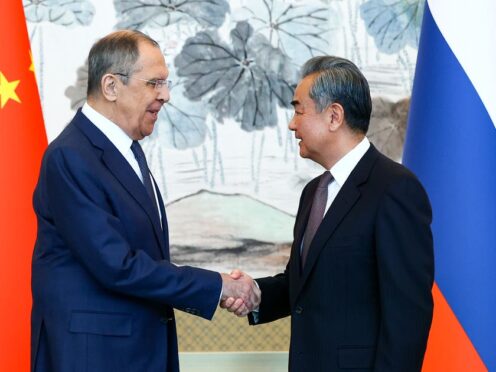
Chinese leader Xi Jinping has met with Russian foreign minister Sergey Lavrov in a sign of mutual support and shared opposition to Western democracies amid Moscow’s invasion of Ukraine.
“We would like to express our highest appreciation and admiration for the successes that you have achieved over the years and, above all, over the last decade under your leadership,” Mr Lavrov told Mr Xi, according to Russian media.
“We are sincerely pleased with these successes, since these are the successes of friends, although not everyone in the world shares this attitude and are trying in every possible way to restrain the development of China — in fact just like the development of Russia,” Mr Lavrov said.
Russia’s growing economic and diplomatic isolation has made it increasingly reliant on China, its former rival for leadership of the Communist bloc during the Cold War.

In past decades, the two have closely aligned their foreign policies, held joint military exercises and sought to rally non-aligned states in groupings such as the Shanghai Cooperation Organisation.
Mr Lavrov held a news conference earlier on Tuesday with his Chinese counterpart Wang Yi at which they reaffirmed solidarity in international affairs.
Mr Lavrov said Russia and China oppose any international events that do not take Russia’s position into account.
He said Ukrainian President Volodymyr Zelensky’s “so-called peace formula” was “completely detached from any realities”.
Mr Zelensky has called for the withdrawal of Russian forces and the return of all occupied Ukrainian territory, but is heavily reliant on support from the US, where the Republican Party majority in the House of Representatives has been holding up a new military aid package.
China and Russia are each others most important diplomatic partners, both holding permanent seats on the United Nations security council and working together to block initiatives by the US and its allies to spread democratic values and human rights from Venezuela to Syria.
While China has not provided direct military support for Russia, it has backed it diplomatically in blaming the West for provoking Russian President Vladimir Putin’s decision to launch the war and refrained from calling it an invasion in deference to the Kremlin.
China has also said it is not providing Russia with arms or military assistance, although it has maintained robust economic connections with Moscow, alongside India and other countries amid sanctions from Washington and its allies.
At their joint news conference, Mr Wang repeated China’s calls for a ceasefire and “an end to the war soon”.
“China supports the convening at an appropriate time of an international meeting that is recognised by both Russia and Ukraine, in which all parties can participate equally and discuss all peace solutions fairly,” Mr Wang said.
China’s peace proposal has found little traction, in part due to the country’s continuing support for Russia and lack of vision for what a future resolution would look like, particularly the fate of occupied Ukrainian territories and their residents.
Mr Wang also said Mr Xi and Mr Putin would continue to maintain close exchanges this year amid expectations of visits to each other’s capitals.
“China and Russia have gone through ups and downs, and both sides have drawn lessons from historical experience and found a correct path to promote the healthy and stable development of bilateral relations,” Mr Wang said.
“Today’s good relations between China and Russia are hard-won and deserve to be cherished and carefully maintained by both sides.”
Mr Lavrov arrived in China on Monday, while Mr Wang and other leading Chinese figures have recently visited Russia and maintained China’s line of largely backing Russia’s views on the cause of the conflict.
China has at times taken an equally combative tone against the US and its allies. China and Russia have held joint military drills, and are seen as seeking to supplant democracies with dictatorships in areas where they wield influence.
China is involved in its own territorial disputes, particularly over the self-governing island of Taiwan and in the South China and East China Seas.
Just weeks before Russia invaded Ukraine, Mr Putin visited Beijing for the opening of the 2022 Winter Olympics and the sides signed a pact pledging a “no limits” relationship that has China supporting Russia’s line, even while formally urging peace talks.
In a phone call last week with Chinese leader Xi Jinping, US President Joseph Biden pressed China over its defence relationship with Russia, which is seeking to rebuild its industrial base as it continues its invasion of Ukraine.
And he called on Beijing to wield its influence over North Korea to rein in the isolated and erratic nuclear power.

Enjoy the convenience of having The Sunday Post delivered as a digital ePaper straight to your smartphone, tablet or computer.
Subscribe for only £5.49 a month and enjoy all the benefits of the printed paper as a digital replica.
Subscribe